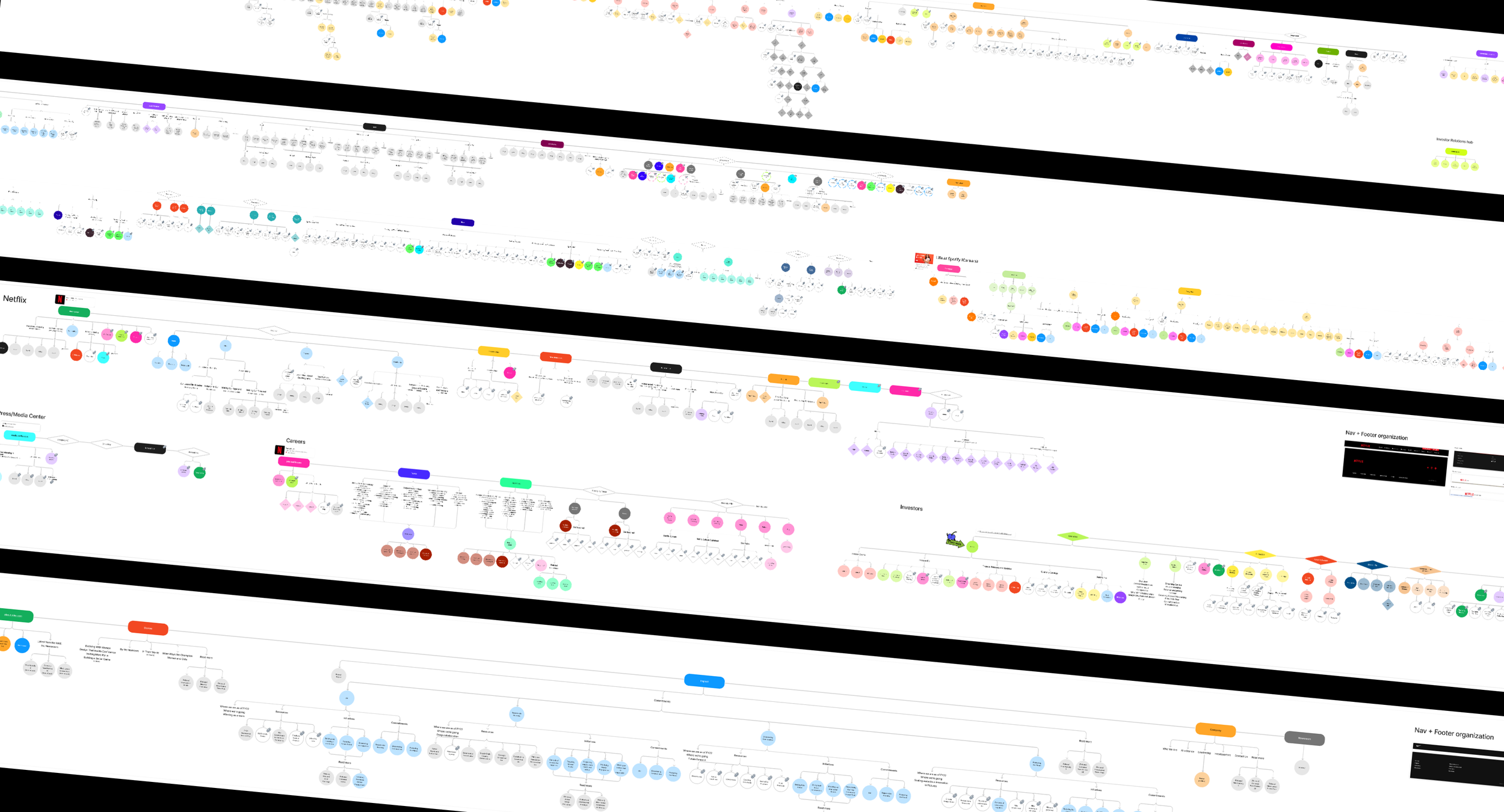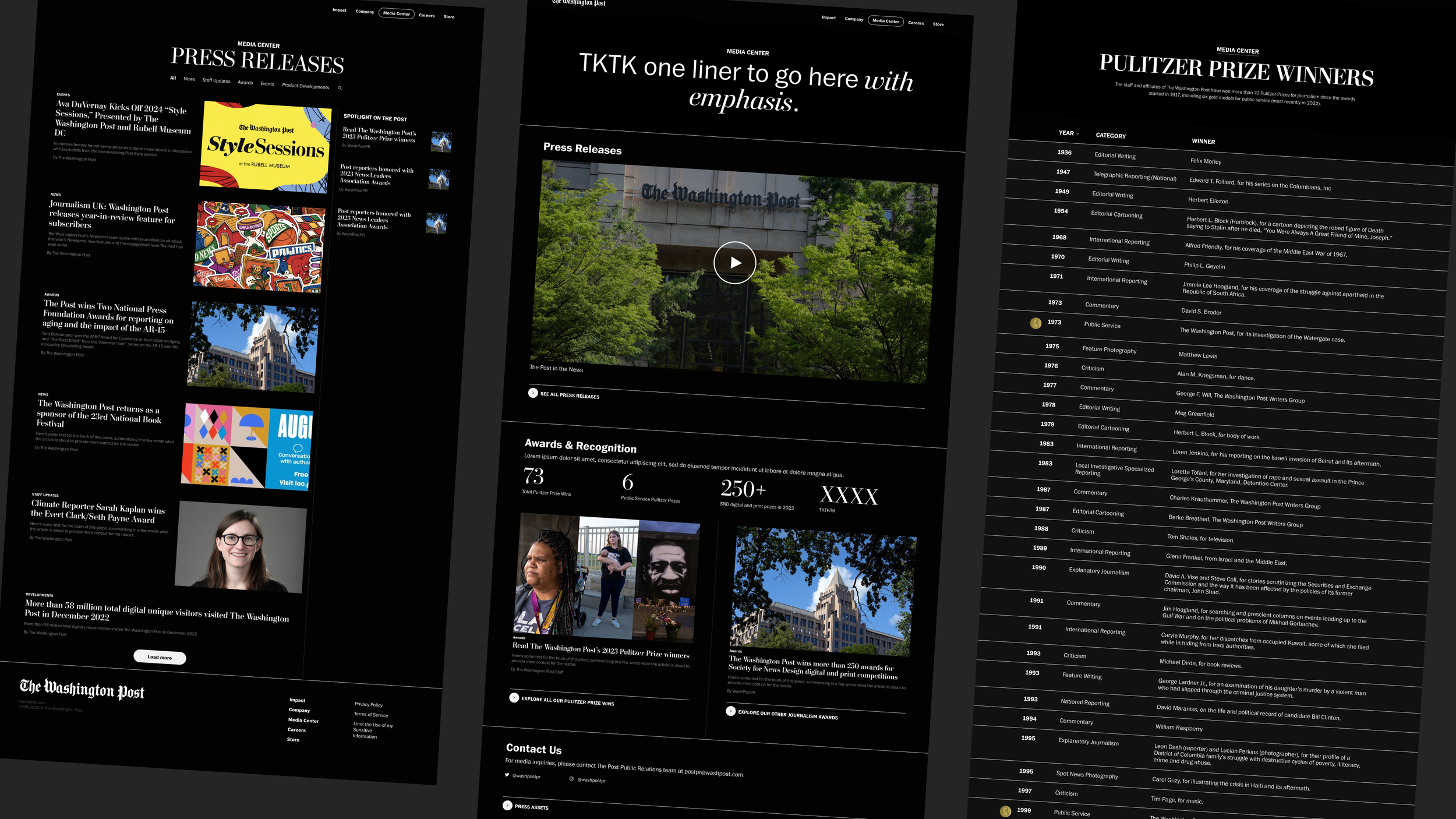
The Washington Post Corporate Website (WIP)
The Washington Post has been in circulation for over 147 years, and as of 2024, still has no corporate presence or hub. The creation of a corporate site began before my tenure at The Post and came to a pause due to personnel changes, but was rebooted in 2022 to launch alongside the new CEO Will Lewis’s new business plan on how he intends to move the company forward.
Context
When I joined The Washington Post’s Brand Team, it had just inherited a project that has bounced around a number of owners and stakeholders: the company’s official corporate website. We were passed along a prototype, designed and built by Pentagram, that did not represent the company’s mission and current goals of The Post’s editorial and public relations personnel.
I became tasked with:
Designing the corporate site anew. From scratch.
Working with my manager, our copy director, and stakeholders across the company to gather and rethink the content of the site
Collaborating with other product designers and engineers to push the boundaries of our existing design system to create a bespoke web experience that still sings with the original Washington Post web product.
A number of challenges have presented themselves since the “re-kickoff” at the beginning of 2022, and I am leading the charge on identifying and enacting solutions to those problems.
Snapshot of the original build by Pentagram, inherited by my team as the project’s starting point
Challenge #1
Inheriting Pentagram’s build without any formal handoff. The personnel at The Post that had been liaising with Pentagram at this point were all gone, and lost in the shuffle was any documentation that could inform us on why the prototype looks and feels the way it currently does (clunky, disorganized, and with the seamlessness of many user flows leaving much to be desired). I have no access to what user research, if any, had been shared or conducted at the start of this process.
Solution
Scrap the entire thing and start fresh! This way we can do this project right and do our due diligence as a company with upfront research and alignment across all stakeholders.

Challenge #2
Inheriting Pentagram’s build without any formal handoff. The personnel at The Post that had been liaising with Pentagram at this point were all gone, and lost in the shuffle was any documentation that could inform us on why the prototype looks and feels the way it currently does (clunky, disorganized, and with the seamlessness of many user flows leaving much to be desired). I have no access to what user research, if any, had been shared or conducted at the start of this process.
Solution
Scrap the entire thing and start fresh! This way we can do this project right and do our due diligence as a company with upfront research and alignment across all stakeholders.
Sitemap originally created by our then Chief Communications Officer
Challenge #3
Lack of alignment on a centralized purpose. Multiple executives, VPs, and other stakeholders agree that as a company we need this hub to be built, but those key players have yet sat down to discuss and align on what it is they need this site to accomplish.
This lack of alignment has resulted in a site structure that was arbitrarily built by an executive (not a UX expert) and does not reflect the desires and needs of the company holistically. For example, certain stakeholders getting hung up in what they want in the site’s primary navigation as a means of showcasing the company’s most important public-facing values, but understandably without thinking of if certain placements make sense from a UX perspective.
Solution
To people manage in a bottom-up manner and encourage stakeholders to change their thinking framework to something user-centric, I have taken the following steps:
Conducted comprehensive competitive audit for research and also to provide stakeholders with tangible references on what the existing landscape looks like
Simultaneously, I overhauled the site organization and am redesigning it based on information I prompted and gathered from other departments (who I know are going to be responsible for certain sections of content) and user flows I determined we will want
Snapshot of my “A Beautiful Mind”-esque behind the scenes work
My WIP sitemap proposal

Challenge #999
Evolving public relations’ team needs. Upon the inception of the public relations hub on the corporate site, currently named “Media Center,” there was not much thought behind how The Washington Post PR Blog would fold into the product. The Media Center underwent a number of changes with its approach to content, from originally housing a curated spotlight of PR Blog pieces, to now needing to preserve the functionality of the PR team writing and publishing content autonomously – notably at odds with the team’s original desire for the Media Center to feature a bespoke “highly visual” look and feel, due to limited design customizability within The Post’s internal CMS-enabled platforms.
Solution
I reorganized flows and interactions in order to isolate instances that require building within our CMS-enabled platforms to their own subpages within the Media Center, enabling maximum potential for bespoke design while preserving writing and publishing processes that the PR team is already accustomed to.
Select screens
Outcome
Business priorities shifted suddenly and drastically over the course of this project, and ultimately the corporate site project needed to be paused in order to focus on other pressing needs. However, my work on the site and pursuit of a singular mission statement identified greater unique brand positioning work that needed to be prioritized ASAP amongst the company’s newly defined priorities.
Role: Product design, branding, visual identity
Tools: Figma, Photoshop, Illustrator
Team: Tova Diamond (superviser), Sheila Hayes (copy)
Duration: 2022 – ongoing










